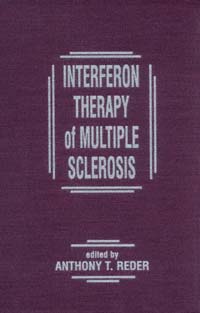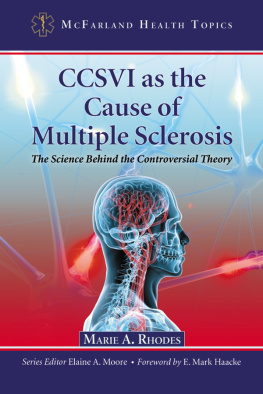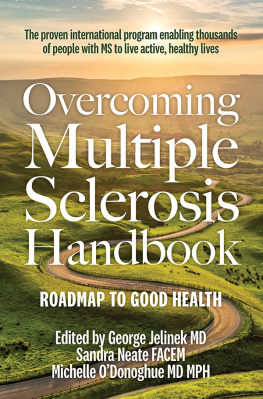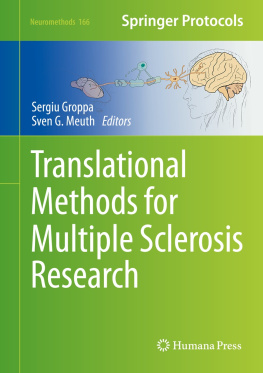Cover

| title | : | Interferon Therapy of Multiple Sclerosis |
| author | : | Reder, Anthony T. |
| publisher | : | CRC Press |
| isbn10 | asin | : | 0824797647 |
| print isbn13 | : | 9780824797645 |
| ebook isbn13 | : | 9780585384108 |
| language | : | English |
| subject | Multiple sclerosis--Immunotherapy, Interferon--Therapeutic use, Multiple Sclerosis--therapy, Interferons--therapeutic use, Interferons--pharmacology. |
| publication date | : | 1997 |
| lcc | : | RC377.I553 1997eb |
| ddc | : | 616.8/3406 |
| subject | : | Multiple sclerosis--Immunotherapy, Interferon--Therapeutic use, Multiple Sclerosis--therapy, Interferons--therapeutic use, Interferons--pharmacology. |
Page null01
INTERFERONTHERAPYof MULTIPLESCLEROSIS
Page null02
Page i
INTERFERONTHERAPYof MULTIPLESCLEROSIS
edited by
ANTHONY T. REDER
University of Chicago
Chicago, Illinois

Page ii
Library of Congress Cataloging-in-Publication Data
Interferon therapy of multiple sclerosis / edited by Anthony T. Reder.
p. cm.
Includes index.
ISBN 0-8247-9764-7 (hardcover : alk. paper)
1. Multiple sclerosisImmunotherapy. 2. InterferonTherapeutic
use. I. Reder, Anthony T.
[DNLM: 1. Multiple Sclerosistherapy. 2. Interferons
-therapeutic use. 3. Interferonspharmacology. WL 360 I596 1997]
RC377.I553 1997
616.83406dc21
DNLM/DLC
for Library of Congress
96-39953
CIP
The publisher offers discounts on this book when ordered in bulk quantities. For more information, write to Special Sales/Professional Marketingat the address below.
This book is printed on acid-free paper.
Copyright 1997 by MARCEL DEKKER, INC. All Rights Reserved.
Neither this book nor any part may be reproduced or transmitted in anyform or by any means, electronic or mechanical, including photocopying,microfilming, and recording, or by any information storage and retrievalsystem, without permission in writting from the publisher.
MARCEL DEKKER, INC.
270 Madison Avenue, New York, New York 10016
Current printing (last digit):
10 9 8 7 6 5 4 3 2 1
PRINTED IN THE UNITED STATES OF AMERICA
Page iii
Preface
Multiple sclerosis (MS) affects 300,000 people in the United States and 1million worldwide. It typically strikes an intelligent, educated woman justas her career and family life begin to flower.
Interferon- (IFN-) is the first and only FDA-approved therapy tochange the course of MS. Its mechanism of action in MS is unknown. IFN- has been approved for treatment of relapsing/remitting and relapsing/progressive MS, but this is only one part of a spectrum of demyelinatingdiseases. Arguably, MS includes monosymptomatic demyelination,optic neuritis, transverse myelitis, primary progressive MS, Devic's disease, postinfectious encephalomyelitis, and possibly Leber's optic atrophy, and adrenoleukodystrophy. Would interferons treat any or all ofthese?
Drug trials in MS are particularly difficult. Large numbers of patientsmust be studied over yearsthe time between exacerbations averagestwo years, and progression is typically slow (at least from the examiner'sviewpoint). The Kurtzke disability rating scale is certainly nonlinearthechange from a Kurtzke rating of 4 to 5 is four times as fast as the changefrom 6 to 7. Experienced neurologists are requireddisease symptomsencompass every function of the central nervous system, and attacksrange from inconsequential to devastating. The natural history alsochanges over timeattack frequency declines, and relapsing disease becomes progressive. Finally, medical care and patient motivation and outlook affect the results; study patients taking a placebo drug do better thanuntreated patients.
Page iv
The rationale for using IFNs to treat MS has evolved side by side withthe most popular views of the cause of the disorder. In the early 1980s,IFN-, IFN-, and IFN- were all advanced as therapies for MS becauseof their antiviral effects, since many investigators hypothesized that MSwas caused by a virus. Unfortunately, IFN- caused exacerbations, andthe virus remains elusive. On the basis of relatively thin evidence, MSis now widely assumed to be caused by an immune reaction to brainantigens. All forms of IFN could alter this immune response, but do soin different directions. Regardless of their effects on immunity, the benefitfrom type I IFN therapy in MS does suggest that IFNs are somehowinvolved in the etiology of MS.
The type I IFN family contains four gene families (IFN-, , , and). In addition, there are multiple natural preparations and recombinantsubtypes. IFN-n3, IFN-2a, and IFN-2b are approved in the UnitedStates for various indications; IFN-1a and IFN-1b are approved for MS.The spectrum of indications for use of IFNs is even broader in Europe.Understanding IFN-receptor interactions, signaling, pharmacokinetics,and clinical effects should optimize treatment of MS and other diseases.
MS is the first inflammatory/autoimmune disease to be successfullytreated with IFNS. Therapy with recombinant cytokines is in its infancy,yet much has been learned from our experience with IFNS. Although typeI IFNs are not a cure for MS, they offer a building block. Interferons willpotentially synergize with other treatments under study in MS, such ascytotoxic drugs/chemotherapy, glucocorticoids, cyclosporine, cAMP agonists, specific immunomodulators, anti-macrophage agents, copolymer-I,T-cell receptor/HLA/adhesion/costimulatory molecule blockade or elimination, oral tolerance to central nervous system antigens, and other cytokines or cytokine antagonists.
This book covers the role of interferons in the treatment of MS. Itbegins with the molecular biology of IFN binding to its receptors, thesignal cascade within the cell, gene regulation, and the induction of IFN-stimulated genes. This is followed by a description of IFN pharmacokinetics. Next, response to IFNs is discussed at the cellular level in neurons,glia, and immune cells. Experimental allergic encephalomyelitis (EAE) isused as a model of MS for reviews of therapy with oral and systemic IFN-, IFN-, and IFN-, and the newly discovered IFN-. Finally, there areclinically oriented descriptions of the benefits and also the side effects ofIFN-, IFN-la, and IFN-1b in MS, and the role of current and futuremagnetic resonance techniques for imaging MS lesions.
The target audience for this book is widebasic scientists in biotechnology and academia, neurologists, other clinicians, and health careprofessionals who treat MS patients, and also pharmaceutical sales repre
Page v
sentatives, MS clinic personnel, and patient groups, such as MS Societychapters. Efforts were made to ensure clarity; each chapter was writtenin depth and should serve as reference source for its area.
Next page












